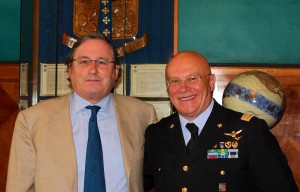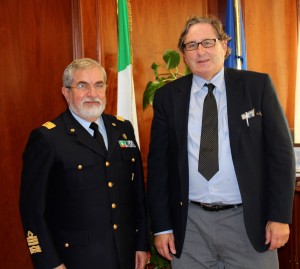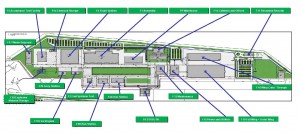2013-11-04 By Robbin Laird
The Italians were significant innovators at the beginning of the era of airpower.
They continued throughout the history of airpower to innovate and with the launch of the F-35, they are proving to be innovators once again.
Their facilities at Cameri provide support not only for Italian aircraft, but anticipate an ability to support an allied F-35 fleet operating in the Mediterranean and the Middle East.
The innovation does not stop there.
It is inherent in the Italian thinking about the concepts of operations of the airplane and its contribution to Italian defense and security. In a recent interview with Lt. General Pasquale Preziosa, the Italian Air Force Chief of Staff underscored that the F-35s will provide the kind of flexibility necessary for airpower over the period ahead.
And he highlighted that the Italian Air Force will be deploying a mixed fleet of F-35s (As and Bs) because they believe that they need to deploy to the mission and not the airfield.
This anticipates the kind of learning the USAF and USMC will shape as they deploy As and Bs to Japan starting in 2015.

Earlier, we provided an interview, which highlighted the Italian effort and provided an update at the time. In an interview with Brian White and Kris Yowell, two LM employees involved with the standup of the facility.
As White concluded the interview, he underscored:
The Italians understand the investment they’re making and they are master strategists in understanding the long-term ramifications. For them, it’s not about buying a jet or being able to produce a jet, it’s about helping their economy, creating jobs, creating an infrastructure in-country that is part of a global enterprise that has things coming in to Italy.
It extends far beyond just the Italian F-35 jets that they intend to buy, it’s their partners that are suppliers on the F-35 program. It’s their wing-line that supports not only Italian jets, but also all the partner countries.
And they are positioning themselves; again, to be the MRO, a new resource in country and they’re very forward-thinking in setting up that infrastructure now far ahead of there being any ability to definitively say yes, you have that work.
I recently had the chance to visit the Cameri facility and with the Japanese about to announce the launching its own F-35 manufacturing facility as well, one can see some implications for the F-35 as a global program.
And I was able to see first hand that White was not overstating the case. But as well there are a number of lessons learned at Cameri which affect the entire future of the F-35 program and its roll out in the Pacific as well.
The F-35 facilities are built on the Cameri Air Base which is a logistics hub for the Italian Air Force. Eurofighters, and Tornados are maintained at the base.
There are various other facilities as well consistent with an airframe sustainment facility.
The location at a logistics hub really is the heart of the story.
Although an assembly facility, the sweep of the facility is really about the ability to support the F-35 fleet operating in Europe, the Mediterranean and the Middle East.
And the core lesson which comes from the standup of this facility is that shaping operational support for the F-35 fleet is a core business for allies as they acquire their planes and shape the fleet in their region.
If one looks at the usual photo of the facility, one sees an overhead shot of the Final Assembly and Check Out or FACO facility. If this is what you have seen, you are not prepared for what you will experience when you come to the campus.
It really is an F-35 campus on which the Italians have built 22 buildings which represent more than a million square feet of covered work areas.
The facility will include a final paint facility for the F-35 as well as the only ATF (Acceptance Test Facility for verifying the F-35 radar signature) in Europe.
The facility is operated by Alenia Aermacchi (AAeM) and contains three sectors of activity, two underway and one in planning.
- The first is for the final assembly of the Italian F-35As and Bs, and the first jet is being currently worked on.
- The second is a wing assembly facility where the Italians will produce at least 835 wings for the airplane.
- The third is really a laydown for the future of the F-35 fleet engaged in operations in the region.
In a recent comment made during an audit at the Chamber of Deputies Defense Commission, the Finmeccanica CEO Alessandro Pansa highlighted that with the participation in the F-35 program “the Italian industrial system brings home potential returns for $ 10 billion” and jobs exceeding 5,000 people.”
The development of these potentialities “depends on our capability to use the infrastructures which have been created to build components and to provide maintenance related to avionics and electronics both for the European aircraft and the US aircraft based in Europe. There’s no other European plant with the same requisites as our plant in Cameri”
Pansa underscored that 90 Italian companies are involved in the program and so far contracts have been let for $765 million.
(From the Italian newspaper, Italia Oggi, October 17, 2013).
And when visiting the plant, it is obvious that the workforce is a mix of older and younger workers, and provides a significant boost to the future of Italian aerospace and defense.
It is also difficult to argue with the proposition that the Mediterranean and the Middle East will not be a busy operational area for NATO and allied forces.
The F-35 fleet that rolls out from a diversity of users will need the kind of operational and maintenance support which can be provided at Cameri.
The Italians have built major warehouse facilities to hold parts for the F-35 as well as maintenance bay accommodations secured to collateral SECRET, and, with the IT system which can manage the parts which are stamped with common parts identifiers, it will be straightforward to manage the inventory coming in and out of these warehouses to support an allied fleet.
A way to look at this would be the shape a graphic as follows with Cameri as the hub to support the Western and Eastern Mediterranean and the entire sweep of allied F-35 fleet operations. This could include the USAF, the USN, the USMC, the Italian forces, the British forces, the Norwegian forces, etc.
The Italians have understood the F-35 fleet concept and have laid down an infrastructure to support it AT THE SAME TIME as they built their FACO and wing production facility.
As we have written elsewhere, the F-35 fleet is at the heart of a reworking of US defense strategy in the Pacific. And the Japanese emulating in part of the Italian example can position themselves for fleet support as well.
(See our new book, Robbin Laird, Ed Timperlake and Richard Weitz, Rebuilding American Military Power in the Pacific: A 21st Century Strategy, Praeger Publishers, published on October 28, 2013).
http://www.amazon.com/Rebuilding-American-Military-Power-Pacific/dp/1440830452
The Italian approach to the F-35, based on fleet support for the F-35 operating in the region, reinforces as well the strategic realities and requirements for Italy and its allies.
It is difficult to imagine the U.S. operating in the Mediterranean without access to Italian bases. With the F-35, Italy can enhance its business in support of the fleet and the USAF operating in Europe as well.
In addition, the operation of allied fleets as well as land-based air can be supported in regional operations as well. The Italian Navy’s Cavour will operate the Bs, along with the British Queen Elizabeth and the US amphibious fleet as well. U.S. large deck carriers will operate the Cs which have significant commonalities with the As and Bs to be operated by the Italian Air Force. This provides significant possibilities for support for the USN C fleet at Cameri as well.
https://sldinfo.com/re-thinking-the-role-of-the-smaller-deck-carrier-the-case-of-cavour/
In other words, the area of strategic operations for the Italian forces, those of allied forces operating in the Mediterranean and the Middle East, can dovetail on support from Cameri.
Hidden inside the program is the inherent possibility of naval and air forces collaborating much more effectively than in the past. The reach of the F-35 fleet, which conjoins aircraft operating either of land or sea, is a central combat capability for Italy and its allies in regional operations.

Another lesson being learned by the Cameri FACO standup is the impact of a global manufacturing system upon the F-35 enterprise.
By standing up the FACO facility, Lockheed Martin (LM) is working in partnership with AAeM in shaping a new manufacturing facility. By so doing, LM is not simply transmitting information but learning from AAeM about ways to improve production in Fort Worth.
When the Japanese join the manufacturing side of the program, the contribution of Japanese manufacturing skills will be incorporated into the program as well. I think it would be difficult to argue that the Japanese do not know a considerable amount about manufacturing.
In other words, it is not just about validating the F-35 manufacturing model; it is about U.S. and allied investment in an ongoing process improvement to the manufacturing of the 21st century jet.
Also inherent in the process is the shaping a new approach to US-allied collaboration. The classic trans-Atlantic programs have atrophied and are going to be replaced by blended production approaches, which shape capability shared across the partner nations.
The F-35 is an example of this approach, and Debra Palmer, the Lockheed Martin GM, provided insight into how the process has worked from her perspective. She emphasized that LM in working with AAeM to stand up the facility has involved three packages of team members in the effort:
The first encompasses the expats who are there to help standup the entire project and system. There are about 30 expats at Cameri.
The second encompasses what she calls “long term TDY” and these are technicians and process specialists who are in the plant for a few months and are working on training specific tasks.
The third involves surge support from technicians from the US for less than a month to provide support with regard to a very specific task.
In reverse, Alenia Aermacchi has sent supervisors to Fort Worth for orientation and training in the F-35 program for up to two years at a time.
This is an aspect of this evolving Euro-Atlantic collaboration built into the F-35 program.
And it is clearly not a one-way street.

Lockheed has learned from the Cameri startup ways to improve their processes at the Fort Worth F-35 facility, and significant improvements and processes with savings over time come from such collaborative learning.
Again this is a lesson learned at Cameri, which surely will be repeated as the Japanese stand up their plant working closely with the United States.
And improvements, which come from starting with a fresh, start up plant and working from best practices as one stands up that plant evolve over time into better practices. And these Japanese lessons learned can reach back to both Fort Worth and Cameri.
And this is not a one off, but an ongoing process of collaborative learning.
In short, Cameri is not just about assembling Italian planes or those of selective European partner nations.
It is about inserting itself within the evolution of the future F-35 fleet and becoming a key part of a global production system.
As I wrote many years ago, the F-35 is about culture change.
And this encompasses the manufacturing and support sides of the program as well as affecting concepts of operations.
http://www.defensenews.com/article/20110221/DEFFEAT05/102210314/Embrace-the-Air-Power-Revolution
Located on an Italian Air Force base used for logistics, the Italian government under the management of Alenia Aermacchi (AAeM) has built a 22 building facility to support the F-35 program.
The support comes in three parts.
- First, there is a Final Check Out and Assembly facility, for assembling Italy’s As and Bs, as well as other European F-35 partners, initially the Netherlands.
- Second, there is a wing construction facility with Italy building a minimum of 835 full wings for the F-35 global program.
- Third, with the 22 buildings of more than a million square feet of covered work space comes significant space to build out support for F-35s operated by the US and allies in Europe.
- With the Mediterranean and the Middle East as a busy operational area, the Cameri facility can provide significant operational support to the F-35 fleet operating in the area.
These photos show workers at the FACO working on the first jet.
[slidepress gallery=’cameri-and-the-f-35′]
Credit Photos: Alenia Aermacchi (AAeM)
For additional stories on the Italians and the F-35 see the following:
https://sldinfo.com/cameri-and-the-f-35-building-out-a-new-manufacturing-facility/
https://sldinfo.com/an-update-from-cameri-on-the-cameri-f-35-campus-october-2013/
https://sldinfo.com/building-out-an-f-35-fleet-sustainment-center-in-italy/
https://sldinfo.com/another-aspect-of-f-35-culture-change-building-out-the-cameri-facility/
https://sldinfo.com/visiting-the-italian-air-ministry/
A version of this piece appeared on Breaking Defense as well.
http://breakingdefense.com/2013/11/lessons-learned-at-cameri-italys-f-35-hq-implications-for-asia/
For a special report which examines the role of the Italians in the F-35 program and the approach, see the following:
https://sldinfo.com/flipbooks/Italy/ItalianF-35SpecialReport1/
https://sldinfo.com/cameri-italy-and-the-f-35-special-report/

